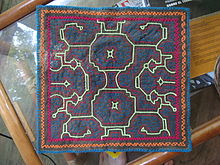Shipibo-Conibo
 Three Shipibo girls in Pucallpa wearing traditional textiles | |
| Total population | |
|---|---|
| 11,000-25,000 | |
| Regions with significant populations | |
| Languages | |
| Shipibo, Spanish | |
| Religion | |
| Christian, Animism[1] | |
| Related ethnic groups | |

The Shipibo-Conibo are an indigenous people along the Ucayali River in the Amazon rainforest in Peru. Formerly two groups, they eventually became one tribe through intermarriage and communal rituals and are currently known as the Shipibo-Conibo people.[2][3]

Lifestyle, tradition, and diet
The Shipibo-Conibo have lived in the Amazonian rainforest for millennia. Many of their traditions are still practiced, such as ayahuasca medicine work. Medicine songs have inspired artistic tradition and decorative designs found in their clothing, pottery, tools, and textiles. Some of the urbanized people live around Pucallpa in the Ucayali region, an extensive indigenous zone. Most others live in scattered villages over a large area of jungle forest extending from Brazil to Ecuador.
Shipibo-Conibo women make beadwork and textiles and are known for their pottery, decorated with maze-like red and black geometric patterns. While these ceramics were traditionally made for use in the home, an expanding tourist market has provided many households with extra income through the sale of pots and other craft items. They also prepare chapo, a sweet plantain beverage.
The Shipibo of the village of Paoyhan used to have a diet of fish, yuca, and fruits. The situation has deteriorated because of global weather changes, however, and now, with drought followed by flooding,[4] most mature fruit trees have died, and some of the banana trees and plantains are struggling. Global increases in energy and food prices have risen due to deforestation and erosion along the Ucayali River.[3][5]
Contact with the developed world—including the governments of Peru and Brazil—has been sporadic over the past three centuries. The Shipibo are noted for a rich and complex cosmology, which is tied directly to the art and artifacts they produce. Christian missionaries have worked to convert them since the late 17th century,[6][7] particularly the Franciscans.[8]
Population

With an estimated population of over 20,000, the Shipibo-Conibo represent approximately 8% of the indigenous registered population[clarification needed]. Census data is unreliable due to the transitory nature of the group. Large numbers of the population have relocated to urban areas—in particular the eastern Peruvian city of Pucallpa and Yarinacocha District—to gain access to better educational and health services as well as to look for alternative sources of income.
The population numbers for this group have fluctuated in the last decades, between approximately 11,000 (Wise and Ribeiro, 1978) to as many as 25,000 individuals (Hern 1994).
Like all other indigenous populations in the Amazon basin, the Shipibo-Conibo are threatened by severe pressure from outside influences, such as oil speculation, logging, narco-trafficking, and conservation.[9][10]
See also
- Guillermo Arévalo
- Shipibo language
- Santa Clara de Uchunya v. Plantaciones de Pucallpa and the Regional Government of Ucayali
References
- ^ "Achuar: Culture." BBC: Peruvian Jungle. (retrieved 4 July 2011)
- ^ Eakin, Lucile; Erwin Laurialy; Harry Boonstra (1986). "People of the Ucayali: The Shipibo and Conibo of Peru". International Museum of Cultures Publication: 62.
- ^ a b "The Shipibo-Conibo Amazon Forest People at the Dawn of the 21st Century".
- ^ Dev, Laura (6 March 2021). "Emergency Disaster Relief for Flooding in Paoyhan". Laura Dev. Retrieved 28 February 2024.
- ^ Bradfield, R.B; James Lauriault (1961). "Diet and Food Beliefs of Peruvian Jungle Tribes. I. The Shipibo (Monkey People)". Journal of the American Dietetic Association. 39 (2): 126–28. doi:10.1016/S0002-8223(21)15477-X. S2CID 239493307.
- ^ Eakin, Lucille; Erwin Lauriault; Harry Boonstra (1980). "Bosquejo etnográfico de los shipibo-conibo del Ucayali". Lima: 101.
- ^ Kensinger, Kenneth M (1985). "Panoan linguistic, folklorisic and ehtnographic research: retrospect and prospect". South American Indian Languages: Retrospect and Prospect: 224–85. doi:10.7560/775923-006. S2CID 243770817.
- ^ Herbermann, Charles, ed. (1913). . Catholic Encyclopedia. New York: Robert Appleton Company.
- ^ Bardales R., César (1979). "Quimisha Incabo ini yoia (Leyendas de los shipibo-conibo sobre los tres Incas)". Comunidades y Culturas Peruanas (12): 53.
- ^ Eakin, Lucille. "Nuevo destino: The life story of a Shipibo bilingual educator". Summer Institute of Linguistics Museum of Anthropology Publication (9): 26.
Further reading
- Olson, James Stuart (1991). "Shipibo". The Indians of Central and South America: An Ethnohistorical Dictionary. New York: Greenwood Press. pp. 330–31. ISBN 978-0-313-26387-3. OCLC 22381053.
- Kennedy, Lauren (April 2011). "La pobreza móvil de los migrantes Shipibo-Conibo: Una investigación de la influencia de la migración en la cosmovisión Shipibo-Conibo de Canta Gallo-Rímac, Lima" (2011)" [An investigation into the influence of migration on the Shipibo-Conibo worldview in Canta Gallo-Rimac]. Independent Study Project (ISP) Collection (in Spanish). Paper 1080.
External links
- Shipibo Conibo Center of New York, NY, USA
- Shipibo art and Conibo art at the National Museum of the American Indian, USA
- Ana Jost is a fashion designer with Shipibo roots.
